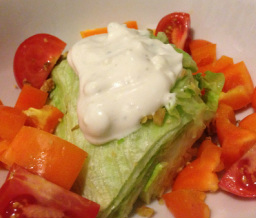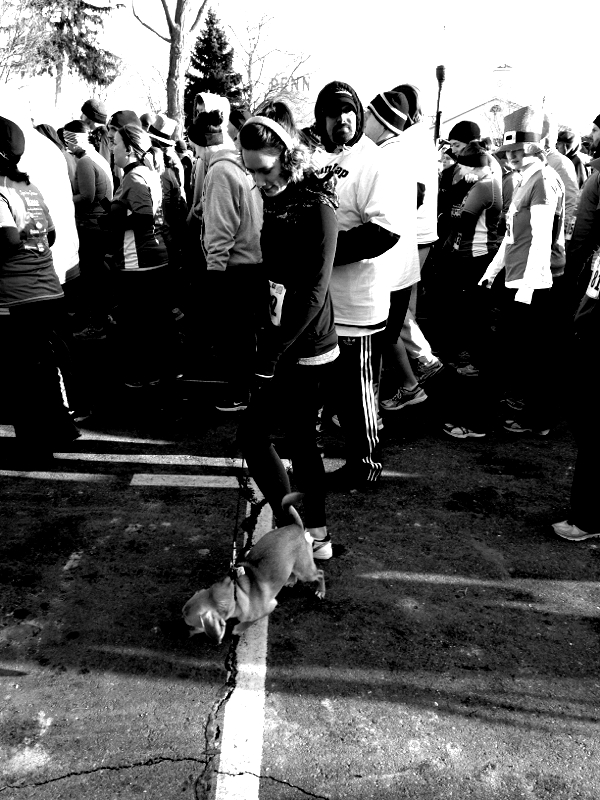10. If you're in danger or trouble, pull the fire alarm. It's better than calling for "help." 9. The best place for a smoke detector is above the corner if a door, that's where the smoke comes through. 8. 97% of fire-related deaths are due to smoke inhalation; NOT burns. 7. A stairway in a commercial building, hospital, etc. should keep you safe for two hours. Walk slowly, you'll be fine. 6. The two most important things to keep by your bed are a flashlight and pair if slippers. 5. In an earthquake, stay inside. 4. If you use your cell phone to call 911, it will actually call your home state. Not a problem if you've never moved, but kind of a problem otherwise. 3. If someone is on fire, aim the fire extinguisher at their face. Burned feet don't kill you. 2. Close the door! 1. Seriously, close the door!! Thank you LAFD.
Remember the feeling on your first day of school? Each year, the month of August was filled with anticipation, shopping, excitement, and anxiety. As children we hoped to find friends in our new classes, in college we dreaded heavy workloads, and in med school we just put our heads down and hoped for the best.
Today I feel a similar anxiety, and a new emotion, fear. In the past month I have crossed the country from coast-to-coast, found an apartment, graduated from medical school, and packed up my entire life in the back of 2002 Pathfinder (save for a set of golf-clubs and a crock-pot that just didn't quite fit) to open a new chapter in a new city with new people... New. New. New.
And amidst all the excitement of "new" is the growing fear of "new." After four years of undergraduate and four years of medical school, I, along with three other interns at Cedars-Sinai and thousands of new doctors across the country, am about to embark on the journey we have worked so hard for and yet I am filled with dread.
This next first day is just one of many to come. And each one, from here on out, asks the questions, am I good enough? am I ready? At some point you have to learn to trust the system-- with real lives at stake, medical schools would not graduate us and hospitals would not hire us, if it compromised a life. Yet, despite this knowledge, there is an inner fear that grips our hearts and twists our stomachs. Despite what our parents and friends may think, and the diploma on the wall may suggest, we understand that our education is really just beginning; a fact that fuels our fears and anxieties.
Each day, I wake up and pinch myself. As the official start date draws nearer, the anxiety grows, the fear gets a little stronger, and it gets more and more real. The pinch hurts. This is not a dream. Or is it just my dream?
The question never seemed so appropriate, nor so poignant as it did following the Boston Marathon bombings earlier this week. On his show, Dan Patrick (as well as many others) repeatedly, and almost rhetorically, asked this question. While many of us hope that our answer would be "to help others," the truth is that we don't know. But for the runners and fans on Monday who faced that very question, hypotheticals removed, there were many who answered heroically.
Stick around a race long enough and you'll begin to hear tales of the wall. It is the stage of endurance races where you reach your physiologic limit. Most common in triathlons, marathons, and long cycling events, "hitting the wall" (or "bonking") describes a state of altered consciousness. Athletes describe hallucinations, confusion, dizziness, and utter loss of control to the point of an out of body experience as they push to the end of a race. The physiology is incompletely understood and has been attributed to energy depletion, dehydration, and nervous system dysfunction. The effects are disastrous as we see runners wobble, stumble, and struggle through until they fall or finish.
Mondays attacks were an extracorporeal wall. And yet they seemed to tear down the very wall they represented. Out of the smoke, amidst the chaos, we saw runners go beyond the marathon they were racing to give blood and help their fellow competitors. For those who were stopped short of finishing the 26.2 mile course, they added extra miles to the nearest hospital or to the reunion area where they found family and friends.
The thing about running is that for 99-plus percent of us, it is not a livelihood but a lifestyle. We run for fun and for fitness, for peace, serenity, and camaraderie. And in so doing, we form special bonds- a silent nod to the man we pass every day on our favorite loop or the collective energy as we gather en masse at the start of a race. We are out there for the love of sport and the love of life. The tragedy of the Boston Marathon will endure in infamy, but already we have bonded together and those runners who continued on to donate blood showed their heroism and dedication to this family. Should I ever be asked the question of which way to run, I hope the motto "Boston Strong" pushes me in the right direction.
 I’ve never been one with much affection for cold or inclement weather and as such, between November and April, most of my training is done on the treadmill. While many people lament the monotony and unchanging scenery that treadmill running brings, I take the time to lose myself in podcasts. Recently, during a set of race-pace intervals, I listened to a podcast that featured an interview with Bart Yasso. Yasso is a former champion marathoner, lyme disease survivor, and the chief running officer for Runner’s World magazine with a popular workout named after him, the Yasso 800’s. As someone who travels around the world to race, teach, and meet people, he has the self-proclaimed best job in the world. During the interview, Yasso comments that “winning isn’t the payoff in , but rather the reward is living the lifestyle and embracing the journey. It’s not only about finishing, it is about moving forward.”
Even on the treadmill, this comment gave me pause. I am a competitive person and always have been. I have a strong internal drive that permeates every aspect of my life. From the hospital and OR to the gym and road, I push myself to the point of breaking because I’ve never known another way. Over the years I’ve developed a mental toughness that pulls me out of bed at 4 am to run before heading to work and keeps me up at night, reading papers and textbooks to better care for my patients. Like the treadmill, it sometimes makes my life so regimented that I simply step through the days and forget to enjoy the moment I’m in.
As I move into the next stage as a surgical resident, the responsibilities at the hospital will increase and I will feel myself pulled in more directions than ever before. Mentally and physically, I will be pushed to the limit at work. And yet, this makes those 4-am runs ever more important. They provide moments for reflection so that I may, as Yasso said, embrace the journey.
I will probably never win a race outright. And with my increasing time constraints, I may never be a faster or more competitive runner than I am right now. Still, I will need to remind myself that fitness and health are passions of mine and running is as much of my identity as becoming a surgeon. I must learn to embrace the run for the sake of lifestyle, to not become discouraged if my times drop, and to make sure that I am always following my passions. Only then, when I reach the age of Bart Yasso, can I also have the greatest job in the world.
 The first lines of information for diets are internet homepages, Google sidebars, blogs, and magazine racks in grocery store checkout lines. But when the diet goes wrong or weight loss stops, physicians become the next source of advice. Whether it is family members, friends, patients, or colleagues we are expected to have the answers on fitness and nutrition; however, there is a vast deficiency in nutritional education in medical school, leaving us unprepared to adequately advise patients on health and diet.
As a competitive athlete, I’m keenly aware of how nutrition affects performance. Over the years, I’ve experimented with multiple diets and exercise regiments to maximize performance. While I don’t portend to be an expert on the subject, and especially not for high-performance athletes, I have acquired bits of knowledge that have proven useful in both clinical and personal interactions. Here are 5 Rules for Dieting of them that may be helpful to physicians and patients alike in discussing diet:
·
1. The RIGHT diet is any one you can stick to. Now, I know this seems intuitive, but studies have shown that for the majority of diets, weight loss occurs primarily as a result of paying attention to the amount and types of food being eaten, rather than the actual make up of the diet. For many people, recommend a diet that is low-calorie and stresses the importance of fruits and vegetables.
·
2. A calorie is a calorie. It’s true that the basis of weight loss is that we must burn more calories than we take in. It is important for people to calculate their basal metabolic rate (BMR; multiple calculators available online and not to be confused with body mass index, BMI) and then estimate their daily caloric needs. A typical diet should focus on a deficit of ~500 calories per day, leading to ~1 pound of weight loss per week. I prefer the approach of taking a strict BMR and then estimating daily activity rather than using a pre-set multiplier.
3. Not all calories are equal. Unfortunately, there are some calories that are better than others. This reflects our choice of foods: a calorie from an apple or orange is better than that of a marshmallow because these foods contain important nutrients for your immune system, muscle rebuilding, and other bodily and metabolic functions.
4. Eat More Protein. The cows of Chick-Fil-A may be on to something. Dieters should strive for protein to account for approximately 25-30% of their caloric intake. Multiple studies have shown that protein intake is associated with preventing muscle breakdown that sometimes occurs with caloric restriction due to utilization of amino acids in muscle as energy source over fat. Additionally, recent studies have shown that protein may play an even more important role in feeling satiated, a role previously thought to be driven by fat intake. When choosing protein, opt for lean meats like fish or poultry and limit intake of red meats to once weekly.
5. Exercise is important. Exercise burns calories both during and after. A complete exercise routine should include both cardiovascular efforts where heart-rate becomes elevated (target HR for beginners should be 60-80% of the result of 220 – age), as well as strength work which will both promote muscle development and sustained elevated metabolism.
Obesity is a significant problem for America’s economy, health care, disease burden, and cultural perception abroad. Like treating smoking, a gambling addiction, or alcoholism, every step in a right direction; steps that improve weight and promote healthy lifestyles deserve our praise. Remind patients that weight loss often leads to increased energy and improved self-esteem, but don’t allow changes to go unacknowledged. Furthermore, when the changes stop is when we are needed most allay frustrations and instead, encourage maintenance of the healthy eating principles and continued exercise that were adopted during dieting.
If you have any experience with these diets or specific questions, leave your questions below. For more information on specific diets and dieting practices, read on below.
 Yesterday the New England Journal of Medicine published results of the PREDIMED study (Etruch et al. 2013), which examined the effects of an energy-unrestricted, Mediterranean diet, supplemented with either olive oil or nuts, against a low-fat diet on major cardiovascular events, including myocardial infarction, stroke or death by cardiovascular causes. Briefly, following 7447 persons since 2003 showed reduced events in those persons who followed either Mediterranean diet over those on the low-fat diet.
In a 1997 article in the American Journal of Clinical Nutrition,
Barabara Haber traced the Mediterranean diet back to 1614 and an Italian named Giacomo Castelvetro who, unsuccessfully, promoted the consumption of olive oil, vegetables, fruits and limited animal products to the British in exchange for their rather bland, roasted meat-and-potatoes fare. In a parallel article to the PREDIMED study (Something New Under the Sun? Mediterranean Diet and Cardiovascular Health), Sarah Tracy notes that the Mediterranean diet is not a novel approach for Americans, having first been advocated by Ancel Keys in the 1950s and having recurrent appearances since promoting heart health and weight loss.
The virtue of the Mediterranean diet is that it is simple, based in the consumption of fresh vegetables and fruits, nuts, legumes, and cereals, simply prepared and lightly dressed with olive oil, salts, and vinegars. The main sources of protein are fish and poultry with only rare consumption of red meat. And don’t forget the alcohol, the diet accounts for the occasional glass of wine or beer with meals, up to 5-7 per week with no more than two per day. The combination of fats, carbohydrates, and protein in itself is filling and limiting when built into a complete meal.
Eat. Real Food. Not Too Much. These are the seven words I live by when it comes to diet. Eat because we have to; Real food is that which is simply prepared; and with portion control so that I never feel overly full. From salads to roasted vegetables to pasta sauces, I can count on one hand the number of ingredients used to prepare these dishes. I focus on creating a complete menu at every meal that consists largely of vegetables, a portion of protein, and some way to tie it all together as a pasta, stir-fry, or sandwich. I cook so that I can control preparation and portion size and I am constantly searching for healthier ways to prepare my favorite dishes. Yes, there are exceptions. I have my favorite marinades, salad dressings, and sweet treats that satisfy my palate. But these make up only a small portion of my overall intake
Like the PREDIMED study and Giacommo, I am not innovative or novel in my approach. I have my own influences and study multiple recipes by chefs far more knowledgeable and skilled than myself. Furthermore, the PREDIMED study is not the answer to all of our questions on heart health and it did not even consider weight loss as an endpoint (although other studies have shown it to be beneficial in this area as well). The PREDIMED study does reaffirm the need for simple principles when dieting for health because living longer and healthier it is not just a food thing, it’s a lifestyle thing.
I recently re-read the article “Big Med,” by Atul Gawande, in which he examines the future of medical care from kitchen of the Cheesecake Factory. He marvels at the efficiency achieved by Cheesecake Factory in everything from ordering the correct amount of chicken to processing orders to teaching new recipes and dishes. They have maximized the cost-effectiveness of their business, but it was not without significant consumer research, vigilant oversight, and continued modification. What is preventing medical care from achieving similar efficiency?
The increasing importance of guidelines, protocols and algorithms in directing care is pushing medicine in a direction similar to the Cheesecake Factory. When a patient presents with a specific set of complaints, there are now measures in place that dictate the tests and studies that will yield the most likely diagnosis. A 66-year old female with burning on urination gets urine dipstick and culture, and is treated with Bactrim for a likely UTI. Similarly, a 34-year old male with Chrons disease who is 5 days post-op with fever and hypotension will be treated according to Surviving Sepsis guidelines with fluid resuscitation, blood cultures, a specific set of labs and empiric antibiotics. Both of these measures, used in drastically different situations, have been shown to reduce unnecessary testing, costs, and all while improving outcomes.
Still, physicians are hesitant to implement new protocols without seeing sufficient evidence with controlled trials. And for good reason, a patient is a person not a dish leaving the kitchen of the Cheesecake Factory. At the restaurant, we expect today’s crab cake to be the same one that we loved a week ago; patients are each different and we must consider comorbidities, insurance status, medications and allergies, and acute and past medical history. Significant increases in outcomes research to drive the development of protocols is beneficial in identifying significant steps that will maximize treatment with the impetus on improving outcomes and reducing cost, but we must remember that medicine is not a box that patients fit neatly in. We must maintain a sense of autonomy and humanism, taking each patient at face value, and not perform as robots confined to a set of tests and diagnoses.
Guidelines are just that—guides, roadmaps to improve the efficiency of care with regards to outcomes and cost. There is a time and place for the use of guidelines, but not every patient falls neatly within the circumstances in which these guidelines are meant to be implemented. For students being taught in the world or Up-to-Date, MDConsult, and AccessMedicine, we must remember that guidelines and protocols are merely starter recipes for success, but also ones that must be tailored to each patient’s taste.
The envelope felt heavy in my hands, heavier than a few pieces of paper should. The name on front was printed in crisp black ink and while it was my own, it looked foreign. It seemed only days ago that I first slipped into a short, white coat. I was young and eager, bright-eyed and bushy-tailed with 170 other new physicians in training. Over four years of medical school, our aspirations lead us down a multitude of diverging paths, yet today our paths merged once again for a champagne toast and the opening of these envelopes. Inside, the beginnings to our futures were laid out in a few lines, new paths for each of us to follow. My fingers stuck to the edges, unwilling to slide under the seal and make real the inevitable. I could feel my heart beating, a sensation we learned about years ago; I forget the mechanism now. Around me, the sounds of excitement began to grow, confining me even more. What name lay inside, what did I hope for? In moments I would know, and then what? My mind raced ahead to all of the things that will happen in the next two weeks- signing paperwork, fixing financials, securing housing; packing up the life I had built over four years in Ann Arbor and starting anew.
A squeeze on my thigh brought me back to reality and I looked past the envelope to the barren left hand that was turning white with tension. Abagail. After six years, that finger deserved to be adorned. As a career-driven person, I could never back her into a corner with an engagement. But she has been there, through the highest highs and lowest lows of medical school and life. Our tale is one I don’t want to end. I am reminded that the contents of this envelope affect her life every bit as much as my own. I wished we could stop time, enjoy life together without the anxiety and tension that has been building a wall between us. Hoping for the best, we prepared for the worst. I looked up and our eyes met, her soft smile nudged me along, as if to say, "there’s nothing left now, just do it."
More people have discovered their future. They begin to rise from their chairs, family members clapping, and hug or high-five each other. Laughter abound. My hands begin to wake up and feel the sharp corners of the envelope. I begin to slide my finger under the flap and peel away the glue. I cannot help but wonder if I made the right decision, if I chose the best career path, if my rank order was correct. Would I be truly happy with whatever name was written on the piece of paper I was about to read? This was supposed to be the most exciting day of medical school, but it left my stomach in knots. I quickly took a sip of champagne, liquid courage? My hand returned to the envelope and began to rip across the top. I could not be the only one feeling this kind of pressure. I half-admired my classmates who chose to do this in front of everyone and half-wondered if they secretly knew their destination. They all seemed happy to place their pins on the map. Where was my pin going to go?
I pulled out the piece of paper. My hands had new life, though they seemed not my own. I could not control them now. I wanted to stop them, to keep them from revealing my future. I tried to avert my eyes but they were stuck on the unfolding edges. “Dear Justin Steggerda.” There was my name again. This was not a mistake, just a few more lines and I would know. “Congratulations.” My breath caught in my throat. I closed my eyes, the next line carried my future. There is no stopping now. I forced my eyes back open. I read on. I smiled. My future was here.
|




 RSS Feed
RSS Feed